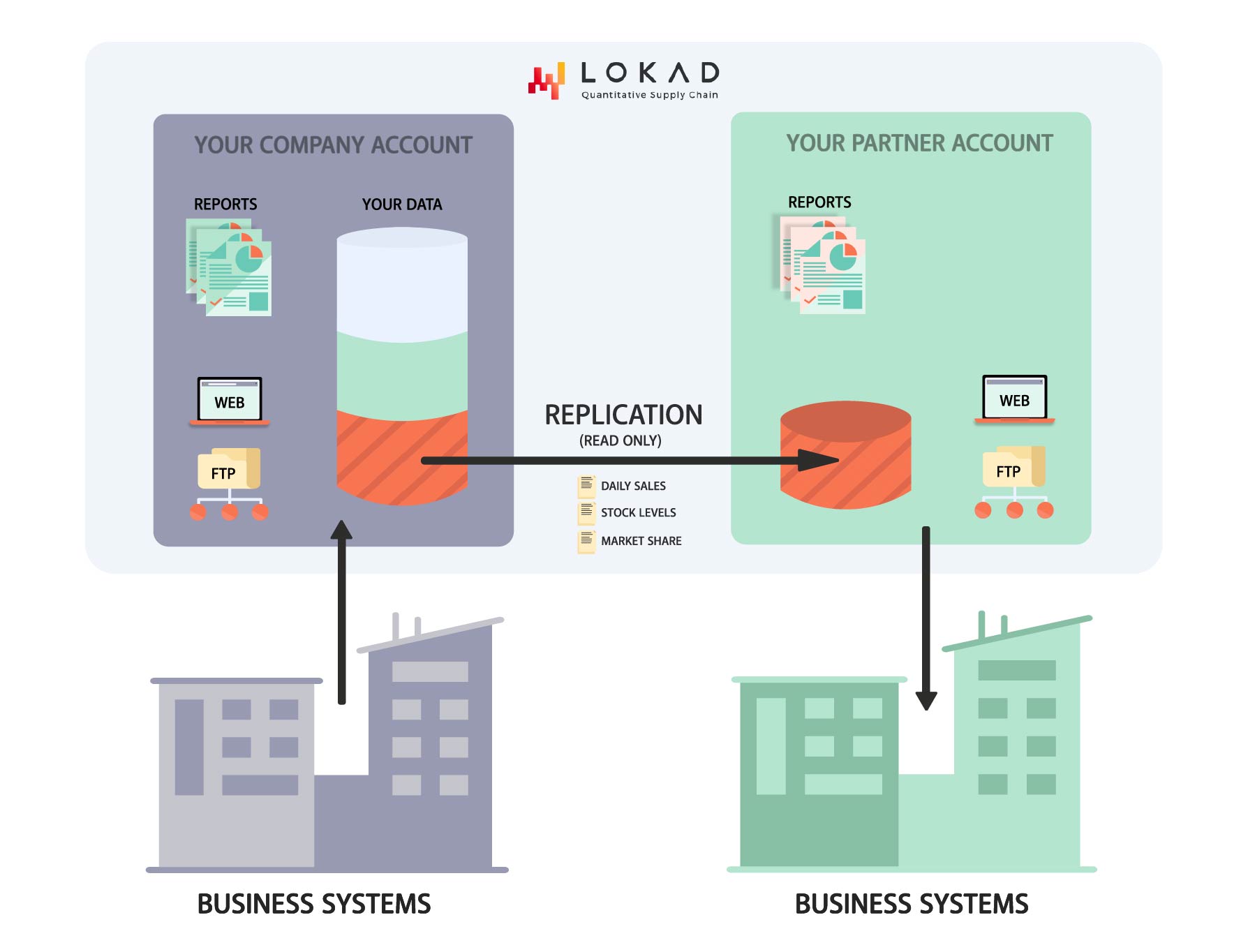協働型サプライチェーン
The performance of your supply chain depends on its integration with your suppliers, customers, transporters, etc. Keeping your partners in the dark is a recipe for poor quality of service, limited agility, and higher operational costs. Sharing actionable information with your trusted partners is one of the cornerstones of a collaborative supply chain. Through the Lokad platform, your company can safely and reliably share data packages, precisely tailored to the specific needs of each of your partners.

1. 協働型サプライチェーンの例
Contoso、大手小売グループは、主要な業務データをFMCGサプライヤーである Fabrikam と共有したいと考えています。ContosoはFabrikamとの供給連鎖の連携を合理化することを望んでいます。具体的には、Contosoは以下の情報を提供する必要があります:
-
日次売上データ:各Contoso店舗でのFabrikam製品ごとの売上データ.
-
在庫レベル:すべてのContoso店舗および倉庫の在庫状況.
-
マーケットシェア:Fabrikamの製品セグメントごとに、各店舗および月単位での市場占有率の洞察.
Crucially, Contoso also shares aggregated market data with Fabrikam’s competitors (who are also Contoso suppliers) in a similar manner, ensuring a fair and confidential approach for all parties involved.
By leveraging the Lokad platform, Contoso can automatically assemble the exact subset of data for Fabrikam—line by line, field by field—while preserving confidentiality and ensuring no performance impact on Contoso’s own operations. Through atomic updates, Fabrikam always sees a consistent snapshot of shared data, even when massive datasets are involved.
Once Fabrikam receives these data feeds:
-
日次売上データ は、今後のContoso注文をより正確に予測・計画するのに役立ちます.
-
在庫レベル は、すでにパイプライン内にある在庫を明らかにし、ブルウィップ効果を緩和します.
-
マーケットシェア の統計は、Fabrikamがプロモーションや地域広告の効果を測定するのに役立ちます.
Fabrikamは、自社のLokadアカウント内で追加の分析やレポート作成を実施し、Contosoから共有されたデータと自社内部の数値を組み合わせることができます。重要なのは、このステップにおいて別途のITインフラが不要である点です.
This seamless and secure data sharing ensures that both companies can focus on optimizing their collaboration rather than wrestling with complex integrations or clunky forecast-sharing processes.
2. 協働型サプライチェーンにおける障害
At the tactical level, supply chain collaboration requires a constant exchange of information about the “state of flow” between partners, e.g., sales data, stock levels, ETAs, etc. Though many might think that the internet age has solved this issue, in reality that is simply not the case. There is more than meets the eye when it comes to easily, reliably, and securely sharing the data required for a fruitful tactical supply chain collaboration.
The Lokad platform addresses this challenge in ways that alternative solutions do not, such as that described in 1. Example Use Case
2.1 セキュリティ
For every partner (e.g., suppliers), the Lokad platform gives you the possibility to delineate the exact data perimeter to be shared.
たとえば, クライアントがサプライヤーとテーブルを共有したい場合、Lokadはクライアントが望むものを_正確に_(必要に応じて行ごとに)共有する機能を提供します。共有される各フィールドについて、Lokadはその内容を(必要に応じて行ごとに)表示または非表示にすることができます.
Moreover, the platform guarantees that the client will experience zero performance degradation when trusted partners (such as suppliers) access the approved portion of shared data.
2.2 表現力
The data to be shared with trusted partners can benefit from preprocessing performed on the Lokad platform. Our platform even makes it possible to share anonymized statistics with the trusted partner on his own biggest segment.
たとえば, 元の業務データは複数のシステムから発生し、共有前に統合される必要があります。また、データにはパートナーを混乱させる可能性のある偶発的なアーティファクトやエラーが含まれている場合があり、Lokadプラットフォームは共有前にこれらを整理することができます.
2.3 完全性
The entire dataset shared with the partner is shared through atomic updates by the Lokad platform. This means that the partner cannot be confused by partial updates of the shared data—even if giganormous datasets are involved. The partner either sees the “old” snapshot or the “new” one.
This property is fundamental to eliminating entire classes of errors and problems for the trusted partner.
2.4 活用性
Analytics, data visualization, and data post-processing can be performed by the trusted partner on the shared data (within the Lokad platform). All of those operations can even be done by leveraging additional data provided by the trusted partner to the Lokad platform. These capabilities ensure that the data being shared can be put to practical use by the trusted partner—without them needing to involve their own IT infrastructure.
3. 予測の共有は良いアイデアか?
Though it is tempting to share forecasts, Lokad strongly discourages this practice. In theory, clients often believe a highly accurate demand forecast should help the supplier achieve high “On Time In Full” (OTIF) scores or high service levels. However, sharing forecasts usually means sharing time-series forecasts, which lack the necessary information to contribute meaningfully to business decisions that should account for the future uncertainty.
For example, time-series forecasts (or “point forecasts”) say nothing about returns, promotions, shelf-life, write-offs, or any of the other specifics that truly matter in your vertical. For this reason, Lokad recommends focusing on sharing facts (for example, data on sales, stock levels, and returns) with suppliers. These are the data that help to generate better decisions, which is why Lokad focuses on sharing this information.
4. Lokad と他の代替技術との比較
There are a large number of alternative technologies for sharing business data. Below find a brief comparison of several of the most popular options.
明確さのために、共有されるデータがERPから発生し、対象企業が各サプライヤーと(各サプライヤーに由来する製品に限定して)日次売上データを共有したいと仮定しています.
4.1 SQL/ETL
-
The company can share its data using an ETL operating on top of a transactional database.
-
SQL does not support granting “row-level” permissions that would be required to share data with a partner.
-
パートナー専用のテーブルを作成する必要があります。また、これらのテーブルは分離されたデータベース内で作成されなければなりません. 信頼できるパートナーが自社データにアクセスすると、システム全体のパフォーマンスが低下する可能性があります.
-
上記のポイント3は、パートナーごとに分離されたデータベースインスタンスを作成・維持することを意味します.
-
さらに、共有データの可視化には別のシステムが必要となり、信頼できるパートナーのIT部門によって管理されなければなりません.
4.2 BI (ビジネスインテリジェンス)
-
企業はBIツールを使用してデータを共有し、信頼できるパートナーに対してカスタマイズされたビュー(各パートナーに合わせた)に制限することができます.
-
残念ながら、この方法では、信頼できるパートナーは共有データに対して自らの分析や後処理を行う能力を欠きます.
-
さらに、共有データをフラットファイルとしてエクスポートし、信頼できるパートナーのITシステム内でさらに利用することは容易ではありません.
-
最後に、このアプローチは計算負荷を伴い、サプライヤーが多数存在する場合、企業のBIインスタンスに悪影響を与える可能性があります.
4.3 FTP
-
企業は、管理されたまたはセルフホストのFTPサーバーを介してフラットファイルを共有することで、データを共有することができます.
-
しかし、この方法には、Lokadプラットフォームが提供する前処理、後処理、およびデータビジュアライゼーションの機能が欠如しています.
-
そのため、企業と信頼できるパートナーの双方が、データの前処理または後処理のためにスクリプト(Python等)を運用する必要があります.
-
さらに、データを可視化するためには別のシステムが必要となります.
4.4 Blob ストレージ (例: S3)
-
企業は、Blobストレージを介してフラットファイルを共有することでデータを共有することができます.
-
このオプションは、実質的にFTPと同一です.
-
Blobストレージは通常、FTPより安価で信頼性がありますが、それでも解決策の_断片_に過ぎず、企業と信頼できるパートナーの二つのIT部門が関与する必要があります.
5. 技術的細則
Each client account with the Lokad platform has its own filesystem. Each filesystem behaves like a Git repository, meaning all changes are versioned and atomic. When files are modified, the filesystem ensures that the change is applied atomically (much like a standard “commit” in Git). The client (in this case, a user or process) of the filesystem can either see the previous version or the old version (there is nothing “in between” these two states). The Lokad filesystem can also be accessed by FTP (SFTP or FTPS).
5.1 フォルダーの共有
Step 1: クライアント企業のメンバーは、Lokadアカウント内で十分なアクセス権を持っていれば、フォルダーを「共有可能」に設定できます(source)。これはウェブインターフェースを通じて行われます.
Step 2: ウェブインターフェースがトークンを発行し、ユーザーはそれを信頼できるパートナーに送信します(ウェブインターフェースを使用して).
Step 3: Lokadアカウントを持つ信頼できるパートナー(destination)が、このトークンを主張します(ウェブインターフェースを使用して).
Step 4: 上記のステップが完了すると、信頼できるパートナーのアカウントに新しいフォルダーが表示されます。この新しいフォルダーは、元のユーザーが共有したフォルダーの完全な複製です.
Note 1: sourceフォルダー(クライアント)に対する変更は、destinationフォルダー(信頼できるパートナー)に反映されます。変更の目標レプリケーション遅延は1分以内です.
Note 2: destinationアカウント内のレプリカフォルダーは読み取り専用です。変更することはできません.
5.2 Envisionの利用
Typically, the source account will get its original data through FTP, mirroring the data exactly as it is found in the business systems. Then, Envision (the programming language of the Lokad platform) is used to populate the source folder with any arbitrary set of flat files representing the (relational) data subset that will be safely shared with the trusted partner.
Envision is also used by the trusted partner to visualize or post-process this data from the destination account. Finally, FTP is also available for the trusted partner, if there is a need to re-integrate this data into their own business systems.